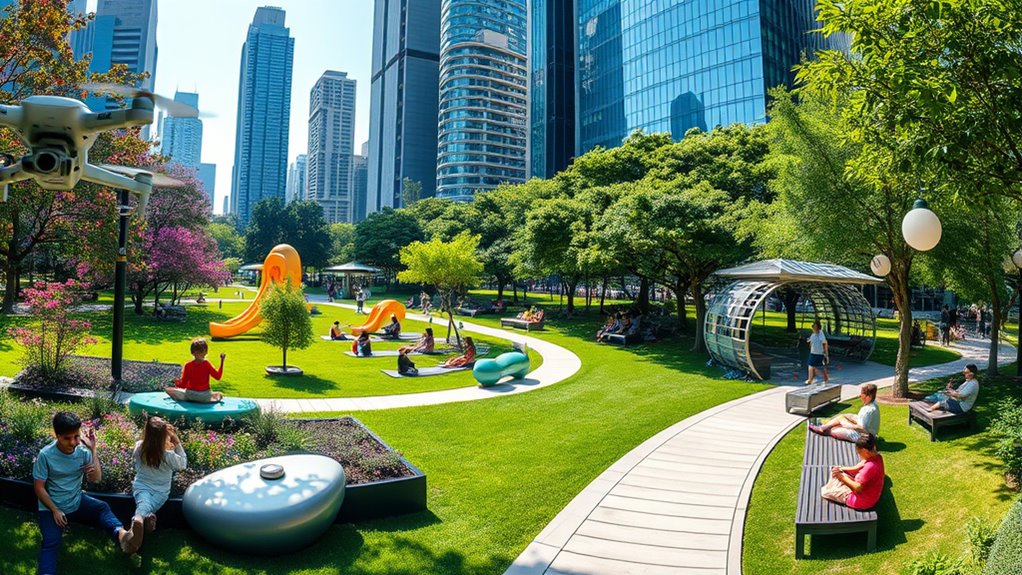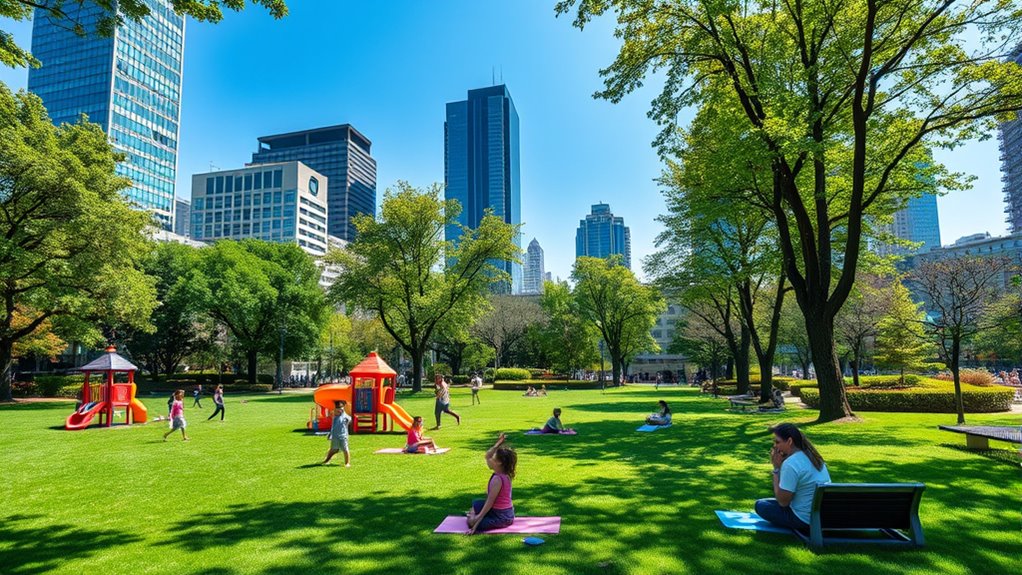In 2025, urban green spaces have markedly improved city life by strengthening community bonds, fostering social cohesion, and promoting biodiversity. Parks and gardens serve as vibrant hubs for social events and volunteer activities, helping you connect with neighbors and develop a sense of ownership. They also protect local ecosystems and support mental health through natural environments. If you want to uncover how these green spaces keep cities resilient and inclusive, keep exploring more about their impact.
Key Takeaways
- Parks in 2025 fostered stronger community bonds through events and volunteer initiatives.
- Green spaces enhanced urban biodiversity, supporting native species and ecological resilience.
- Increased resident participation in green projects improved park quality and environmental sustainability.
- Urban parks contributed to mental health and well-being, offering natural relaxation zones.
- Green areas promoted social cohesion and inclusivity, making cities more vibrant and resilient.

Have you ever wondered how green spaces within cities impact your daily life? These parks and gardens are more than just places to relax; they play an essential role in shaping vibrant, healthy urban environments. When you spend time in a city park, you’re participating in a community that values shared spaces and collective well-being. Community engagement flourishes around these green areas, as residents come together to organize events, volunteer for maintenance, or simply enjoy each other’s company amid nature’s backdrop. This active involvement deepens your connection to your neighborhood, fosters a sense of ownership, and encourages people to care for their surroundings. It’s this spirit of participation that makes urban green spaces indispensable to social cohesion.
Moreover, green spaces contribute profoundly to biodiversity preservation within city limits. They serve as critical habitats for various plant and animal species, many of which might otherwise be pushed out by urban development. By maintaining parks with native flora and creating corridors that connect different green areas, cities help sustain local ecosystems. You might notice birds nesting in trees, butterflies fluttering across flower beds, or bees pollinating plants—small but meaningful signs of thriving biodiversity. These efforts not only support wildlife but also enrich your experience, offering a glimpse into nature’s resilience amid urban landscapes. The preservation of biodiversity in city parks ensures that urban residents remain connected to the natural world, fostering awareness and appreciation for environmental conservation. Additionally, implementing risk management strategies like regular monitoring and community involvement can help sustain these biodiversity efforts over time.
Cities that prioritize green spaces understand that community engagement and biodiversity preservation go hand in hand. When residents participate in planting projects or habitat restoration, they develop a stronger sense of stewardship. This collective effort helps sustain the health and beauty of parks, making them more inviting for everyone. As a city dweller, you benefit from these initiatives; your neighborhood becomes more lively, cleaner, and more ecologically balanced. The presence of diverse plant and animal life also enhances mental health, providing residents with calming natural environments to unwind from urban stresses. In this way, green spaces become living proof of how community involvement directly supports ecological sustainability.
Ultimately, urban green spaces are more than just aesthetic additions—they’re active hubs of community and ecological vitality. They remind you that cities can be sustainable and inclusive, where community engagement leads to a richer, more resilient environment. When you walk through a park or participate in a planting event, you’re contributing to something larger: a city that values both its people and its natural heritage. These spaces foster connection, preserve biodiversity, and improve city life in ways that are felt every day, making urban living more vibrant and meaningful.
Frequently Asked Questions
How Do Green Spaces Impact Property Values Over Time?
Green spaces boost property appreciation over time by making neighborhoods more desirable. When you have parks nearby, your property value tends to increase, especially if zoning regulations favor green development. These regulations can protect green spaces, ensuring they stay a part of your community. As a result, your property’s worth rises, and the neighborhood becomes more attractive for future buyers, leading to sustained appreciation and a better quality of life.
What Are the Costs Associated With Developing Urban Parks?
You should conduct a thorough cost analysis to understand the expenses involved in developing urban parks, including land acquisition, design, construction, and maintenance. Funding sources vary and can include government budgets, grants, public-private partnerships, and community donations. While costs can be significant upfront, investing in these green spaces often results in long-term benefits like improved quality of life and increased property values, making the initial expenditure worthwhile.
How Do Parks Influence Urban Biodiversity?
You’ll notice parks boost urban biodiversity by providing habitats for native flora and fauna. By planting native species, you create a supportive environment that encourages habitat diversity, attracting birds, insects, and small mammals. This not only maintains ecological balance but also enhances ecosystem resilience. Your efforts in preserving native plants and expanding habitat diversity make parks essential refuges, fostering a thriving, balanced urban ecosystem that benefits everyone.
Are There Specific Design Features That Maximize Park Benefits?
You can maximize park benefits through thoughtful landscape architecture that integrates native plants, water features, and diverse habitats. Incorporate recreational amenities like playgrounds, sports fields, and walking trails to encourage activity and social interaction. Design with accessibility in mind, ensuring all community members can enjoy the space. By blending functional features with natural elements, you create vibrant parks that boost health, foster community, and support urban biodiversity.
How Do Green Spaces Affect Mental Health in Urban Residents?
Green spaces considerably boost your mental health benefits by providing a peaceful escape from urban stressors. Spending time in parks reduces your stress levels, improves your mood, and enhances overall well-being. When you engage with nature, your mind relaxes, helping you manage anxiety and depression better. These areas offer a natural way to recharge, making your daily life more balanced and resilient to city pressures.
Conclusion
By now, you’ve seen how parks breathe life into city streets, transforming concrete jungles into vibrant havens. As green spaces flourish, they become the heartbeats of our communities, offering fresh air, joy, and connection. Just like a lighthouse guides ships home, parks lead us back to nature and ourselves. Embrace these green treasures, for they’re the roots that nourish our city’s soul, making urban life brighter and more alive than ever before.










